blog
Interview with featured photographer Natasha Lozinskaya

From ‘Treasure Trove’ © Natasha Lozinskaya
Natasha Lozinskaya sees photography as a way to express the poetry of her homeland. Her featured portfolio “Treasure Trove” in Issue 128 explores the idea of how her youth formed her relationship to the rural Vyatsky Krai area of Russia, both physically and psychologically. She explains that photography is a medium that allows her to explore themes of national identity, nostalgia, and the human connection to place. Lozinskaya’s images walk a fine line between documentary and narrative fiction. She is particularly interested in the social and cultural nuances of the Russian outback, and how they’re reflected in people’s lives and landscapes. Her work often incorporates elements of magical realism and her work draws inspiration from fairy tales, archival materials, texts, and collage techniques.
::
Cary Benbow (CB): Please tell us a little more about the portfolio being featured in this issue. What was the catalyst for this work?
Natasha Lozinskaya (NL): I started a project called “Treasure Trove” a couple of years ago and I’m still working on it. So far, it is the quintessence of all my previous photographic practice. In fact, it is a very personal photo story, although it looks like a collection of fairy tales and mystical legends from one of the regions of Russia. I was born in the city of Kirov, which used to be called Vyatka – and I like this name more, so I use it in the description of the project. I have not lived there for about 20 years, but constantly return and it seems that I can’t leave this place definitively. For me, Vyatka is a connection with my own childhood, with my true identity, which I sometimes lose and sometimes find. This is the place where I was born, where my father and all my ancestors are buried, and very often the collective past of those who lived on this land speaks in me. And here, in this project, I not only tell the story of the region through myths and fairy tales, but also constantly find personal connections with my native land.

From ‘Treasure Trove’ © Natasha Lozinskaya

From ‘Treasure Trove’ © Natasha Lozinskaya
CB: Can you tell us a bit about yourself – what do you feel is the biggest impact on your development as an artist/photographer? Does where did you live or spend your formative years influence the way you work/create?
NL: It seems to me that the main foundation of the artist is formed precisely in childhood – the books we read, the people around us, the places where we grow up, the things and landscapes we looked at. My childhood was spent in Vyatka (the Russian city of Kirov), which I tell about in my photo project “Treasure Trove”. In all my projects I always rely internally on the child’s perception – it supports me, like an inner core, and nourishes inspiration. I grew up on fairy tales and loved writing them by myself. I think this influence is obvious in the photography I create now.
CB: What is your earliest memory of taking photos?
NL: I took my first photos with a simple digital mirrorless camera – I mostly photographed my cat. More conscious photos were taken with my dad’s old film camera (a Zenit). It was a real magic – to figure out how the camera and lens worked, experiment with the settings, try black and white film. I don’t remember what kind of shots I got with it, but I remember very well how I sat for three hours in a dark bathroom and tried to pull out the film that stuck in the camera’s spool.
CB: Overall, what inspires your art? What kind of stories do you wish to tell?
NL: I love the Russian villages very much. And so far I can’t imagine myself as a photographer in another country. It seems to me that the Russian outback and hinterland hold so many secrets and stories worth telling that even a lifetime would not be enough. I like the historical and cultural context that different parts of Russia hold in their memory. Often these stories are dramatic, but I want to tell them as fairy tales – sometimes scary and mystical, sometimes ironic, but they must certainly contain something bright that gives hope.

From ‘Treasure Trove’ © Natasha Lozinskaya
CB: What has made the biggest impact on your career, or left a lasting impression?
NL: My greatest inspiration for developing my photography practice comes from other photographers. Several times I was lucky to meet different photographers who are significant in modern photography. And each time, it was the greatest inspiration and motivation for me to move on. In general I really like photographers – they are almost always very attentive, empathetic and interesting people. I’m curious to know how other photo artists take some photographs, why they shoot on such topics, what their method of working on projects is. I have never felt any competition with them, but on the contrary – inspired and engaged in other people’s creativity.
CB: There are so many ways to express oneself — What makes photography your choice of expression?
NL: Actually, not only photography. I also write texts, and literature, poetry in particular, used to be my main language and way of expression. Photography appeared in my life much later and still seems to me very similar to poetry: photography teaches us to describe reality in the same concentrated and concise way as a poem. In a few lines you need to express an emotion, a feeling, a state, catch the rhythm and make up rhyme. It’s the same in a single photograph. And working on a large photo project is similar to working on a full-fledged novel, where you have to build a narrative, describe the characters and not forget about the form that will unite everything.
CB: In your opinion, what makes a good photograph?
NL: Both the camera and the heart must work in unison. You can take not bad photograph using only your own experience and watchfulness – perfectly reproduce the composition, think through the plot, catch the light and so on. But a good photo only comes when you leave your mind and heart open during the shooting. I haven’t always succeeded in this yet, but it’s impossible not to feel when the “decisive moment” comes.
CB: How do you describe your photography to someone who’s not familiar with it?
NL: For me it’s a difficult question because I can’t fully define the boundaries of the photographic genres and directions in which I work. Rather, at the moment my photography is at the intersection of art and documentary. But I’m still looking for a more precise definition. I would like to find it eventually, because as a poet and writer I prefer to call everything by its proper name.

© Natasha Lozinskaya
CB: If you keep a journal, or write notes about the places and people you see, would you share a meaningful entry?
NL: I keep notes during traveling and photographic assignments. I write more about things in those notes that don’t enter the photo series – for example, about my inner experiences, about dreams, about what remained (behind the frame). I often write and describe the photos not taken because I didn’t have time to shoot or because the moment passed. So for me, photography and literary skills are complementary.
Here is a passage from my notes for example: “I dreamed that I was walking through a non-existent city and taking photos of people. And I felt myself like a wandering hunter, a soul-seeker, the oldest man on earth (such an excitement, even my jaws were clenching). And I saw the shot, and the light was in the air perfectly, and it flowed into the camera and around it, and the scenes were self-assembling, and I couldn’t think of anything else because I was all inside and all outside at the same time. When I woke up, I realized that I had taken my best shot in my dream.”
CB: What advice would you give to someone who wants to take on projects like yours? Or if you could give one piece of advice to your younger self at the start of your career, what would it be?
NL: If you can avoid photography – don’t do photography. It’s very important to enjoy what you do; so much that you can’t exist without it. Your mood could be different, but the skill and desire to photograph is an inner core, a starting point to which you can return both when you are in pain and when you feel good. It seems to me that the people who have found this core – in writing poems, baking delicious pancakes or making good photos – are the happiest. So I would wish for everyone to seek their passion until they find it. And when found, just do not let it go and hone your skills by practice and study.
::
Natasha Lozinskaya is an artist working with documentary and art photography. She was born in Kirov (Russia), graduated from Moscow Literary Institute with a specialization in poetry, now lives and works in Saint Petersburg (Russia) and Krasnodar region (Russia). To see more of Natasha’s work, visit her website https://lozinskaya.com/
Location: Online Type: Featured Photographer, Interview
Events by Location
Post Categories
Tags
- Abstract
- Alternative process
- Architecture
- Artist Talk
- artistic residency
- Biennial
- Black and White
- Book Fair
- Car culture
- Charity
- Childhood
- Children
- Cities
- Collaboration
- Community
- Cyanotype
- Documentary
- Environment
- Event
- Exhibition
- Faith
- Family
- Fashion
- Festival
- Film Review
- Food
- Friendship
- FStop20th
- Gender
- Gun Culture
- Habitat
- Hom
- home
- journal
- Landscapes
- Lecture
- Love
- Masculinity
- Mental Health
- Migration
- Museums
- Music
- Nature
- Night
- nuclear
- p
- photographic residency
- Photomontage
- Plants
- Podcast
- Portraits
- Prairies
- Religion
- River
- Still Life
- Street Photography
- Tourism
- UFO
- Water
- Zine

Leave a Reply